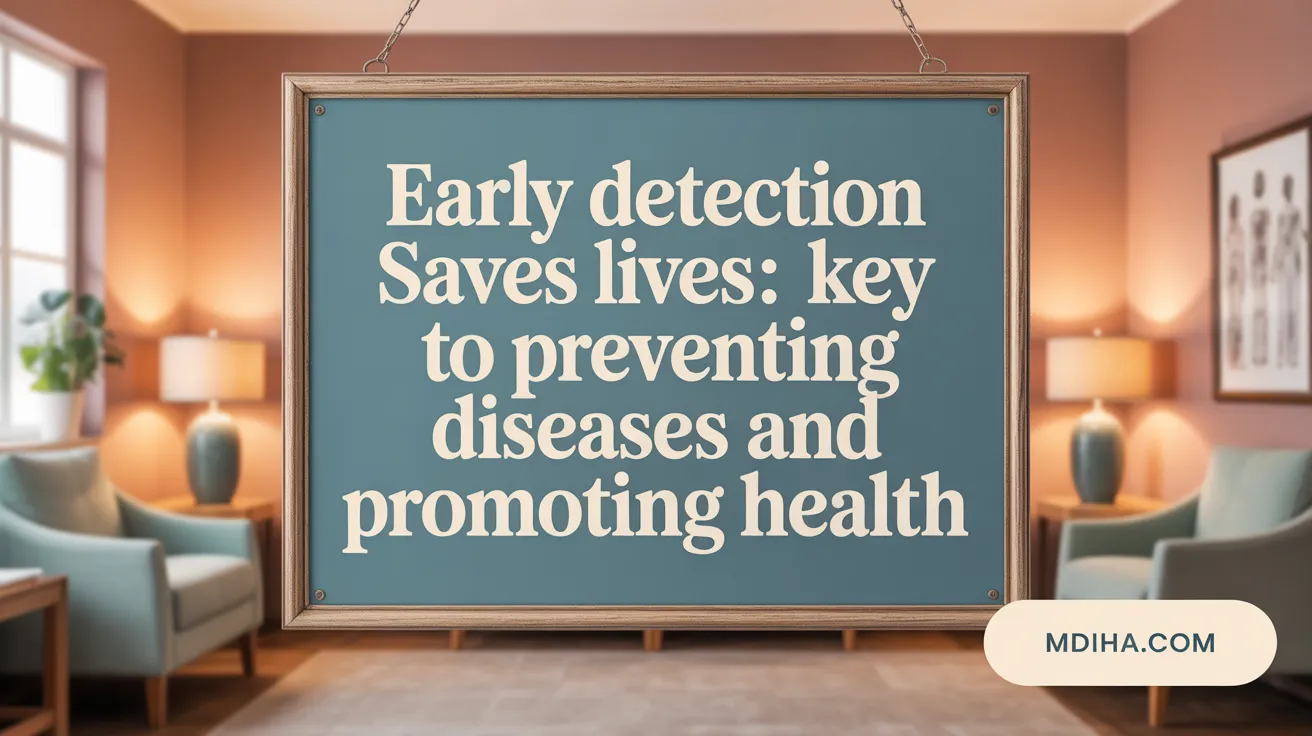The Crucial Role of Early Detection in Longevity Medicine
Early detection has emerged as a keystone in the evolving field of longevity medicine, empowering individuals and clinicians alike to identify health risks well before symptoms arise. This proactive approach promises not only to extend lifespan but also to improve healthspan — the period of life spent in good health. By harnessing advanced screening, diagnostic technologies, and personalized strategies, early detection transforms traditional healthcare into a preventive and individualized model focused on sustaining vitality and function across the aging journey.
Understanding Early Detection in Healthcare and Longevity Medicine
What is the importance of early detection in healthcare and longevity medicine?
Early detection plays a pivotal role in modern healthcare and the promising field of longevity medicine. By identifying potential health problems before symptoms even appear, it enables timely interventions that can halt or slow disease progression. This proactive approach relies on various screening and diagnostic tests, from cancer screenings like mammograms, colonoscopies, and skin checks, to cardiovascular assessments such as EKGs and cholesterol screenings.
Detecting issues early means they are often more treatable and manageable. For example, catching cancers at an early stage significantly improves survival rates, with some cancers seeing over 90% survival chances if diagnosed promptly. Similarly, early cardiovascular risk assessment can prevent heart attacks or strokes through lifestyle changes or medication.
In longevity medicine, early detection extends beyond traditional diseases. It involves advanced diagnostics like biomarker analysis, genetic testing, and wearable health devices that monitor physiological and cellular aging markers. These methods help estimate biological age and identify risks before functional decline begins.
Ultimately, early detection forms the foundation of a personalized, patient-centered care model. It emphasizes prevention, reduces the need for aggressive treatments later, and supports healthy aging by enabling individuals to make informed lifestyle choices. This strategic focus on early intervention improves not only survival rates but also quality of life and long-term healthcare sustainability.
By investing in early detection, healthcare systems can shift from reactive to proactive care, fostering longer, healthier lives with fewer complications and reduced costs. This approach aligns with the core goal of longevity medicine: to extend healthspan while ensuring each individual can age with vitality and independence.
Promoting Healthy Aging and Lifespan Extension Through Preventive Screening

How do early detection and preventive screening promote healthy aging and extend lifespan?
Early detection and preventive screening play a vital role in supporting healthy aging and increasing lifespan. By identifying potential health problems before symptoms appear, individuals can receive timely treatment and management. This approach helps catch chronic illnesses such as cancer, diabetes, and cardiovascular diseases at an early stage when they are most treatable.
Regular health assessments facilitate personalized care plans, allowing for ongoing monitoring of health trends. This proactive strategy helps prevent disease progression, minimizes complications, and maintains independence and quality of life in later years.
Screenings like mammograms, colonoscopies, cholesterol tests, and cognitive assessments are essential tools that detect issues early, often when invasive treatments are avoidable and outcomes are better. Additionally, integrating lifestyle counseling and vaccinations enhances overall resilience against age-related diseases.
By focusing on early intervention, preventive screening reduces healthcare costs in the long run, decreasing the need for expensive treatments associated with advanced diseases. Overall, consistent screening and management enable older adults to stay active and vital longer, promoting a healthier, more productive, and longer life.
Early Detection’s Critical Role in Disease Prevention and Cancer Screening

Why is early detection significant in disease prevention, particularly in cancer screening?
Early detection is vital because it allows for the identification of health issues, especially cancers, before symptoms manifest. When cancers are detected early, they are often at a more treatable stage, significantly improving survival chances. For example, screening tests like mammograms for breast cancer, colonoscopies for bowel cancer, and skin checks for melanoma are designed to catch diseases early, when treatment is most effective.
Implementing regular screening programs helps identify precancerous or early-stage cancers that could be managed with less aggressive therapies, reducing patient suffering and healthcare costs. These programs also help prevent cancers from advancing to more dangerous, less treatable stages, which can lead to better health outcomes and potential cures.
An effective early detection strategy isn’t solely about catching disease early; it also involves accessible, high-quality tests and organized screening efforts. Overcoming barriers such as limited awareness, access issues, and socioeconomic factors is crucial to ensure all populations benefit from early detection.
By focusing on early detection, healthcare systems can lessen the burden of advanced diseases, decrease treatment costs, and improve overall public health. It supports a proactive approach to longevity and healthy aging by catching health issues early enough for successful intervention. Ultimately, early detection is a cornerstone for reducing mortality and enhancing the quality of life across populations.
The Impact of Advanced Diagnostics and Proactive Management on Health Outcomes

What impact do early diagnostics and proactive health management have on long-term health outcomes?
Early detection tools and a proactive approach to health significantly improve long-term wellness. By identifying diseases before symptoms appear, healthcare providers can intervene sooner, which often results in better treatment success and increased survival chances.
Advanced diagnostic technologies, such as blood biomarkers, genetic tests, imaging, and wearable devices, enable clinicians to catch subtle health changes early. These methods can detect the first signs of chronic illnesses like cancer, heart disease, and metabolic disorders, allowing for tailored interventions.
Implementing individualized prevention strategies—such as lifestyle adjustments, targeted therapies, and preventive screenings—can slow or even halt disease progression. This not only enhances patient outcomes but also reduces the need for aggressive treatments, which are typically more costly and have higher risks.
Cost-effectiveness is another benefit. Early diagnosis often means simpler, less invasive care and lowers long-term healthcare expenses. For example, early-stage cancer treatments are less intensive and less expensive than those required for advanced cancer.
Moreover, early detection prevents complications that diminish quality of life, like disability or severe health deterioration. Identifying risks early in neurodegenerative conditions or cardiovascular disease helps maintain functional independence longer.
Altogether, integrating advanced diagnostics and proactive health management into routine care boosts longevity and health quality. It offers a strategic pathway toward healthier aging by maximizing the effectiveness of treatments, reducing costs, and supporting a vibrant, active life.
| Diagnostic Tools | Purpose | Benefit |
|---|---|---|
| Blood biomarker tests | Assess disease risk | Early detection of metabolic and inflammatory states |
| Genetic and epigenetic testing | Identify predispositions | Personalized prevention plans |
| Imaging technologies (MRI, ultrasound) | Visualize internal health | Detect tumors, organ issues early |
| Wearable devices | Monitor vital signs in real time | Continuous health assessment |
| Cancer screening (mammograms, colonoscopies) | Detect early cancers | Significantly improved survival rates |
Using these tools collectively accelerates diagnosis, increases intervention success, and extends healthy lifespan.
Innovations in Early Detection Technologies Enhancing Longevity
What are the recent advancements in early detection technologies, and how do they contribute to longevity?
Recent progress in early detection methods has revolutionized how we approach aging and illness prevention. Wearable health devices, such as fitness trackers, smartwatches, and implantable sensors, now continuously monitor vital parameters like heart rate, sleep patterns, physical activity, and even blood oxygen levels. This constant stream of data enables early recognition of potential health issues, often before symptoms manifest.
Alongside wearable technology, advances in genetic and epigenetic testing provide detailed insights into individual health risks. Tests that analyze DNA methylation patterns can estimate biological age, while comprehensive genomic screenings reveal inherited susceptibilities to various diseases. Biomarkers, including blood-based measures like C-reactive protein, cholesterol, and neurodegenerative markers, further refine early diagnosis.
Artificial intelligence (AI) and large-scale data analytics now play essential roles. Machine learning algorithms process vast health data sets from wearables, medical imaging, and genetic tests to predict disease risks with remarkable accuracy. These predictive models support personalized health plans aimed at mitigating age-related diseases like cancer, cardiovascular conditions, and neurodegenerative disorders.
Digital health innovations extend to mobile apps, telemedicine, and remote monitoring devices, making early detection accessible outside traditional healthcare settings. Blockchain and advanced cybersecurity measures ensure data privacy and security.
This technological shift moves the focus from treating diseases after they occur to preventing them altogether. Early detection enables interventions that preserve functional capacity, improve healthspan, and ultimately extend longevity. By catching conditions early, treatments become less invasive, more effective, and less costly, ushering in a new era of proactive, personalized medicine.
Strategic Importance of Personalized Approaches and Early Intervention for Healthy Aging

Why are personalized approaches and early intervention strategically important for healthy aging?
Personalized healthcare strategies are vital in promoting healthy aging because they focus on tailoring prevention and treatment plans to an individual's unique genetic makeup, lifestyle, and environmental factors. This personalized approach ensures that interventions are more effective, reducing the risk of age-related diseases such as diabetes, cardiovascular issues, and cancers.
Early intervention plays a crucial role by detecting health risks at stages when they are most manageable. Using advanced diagnostics, including biomarkers, genetic, and epigenetic testing, healthcare providers can identify signs of metabolic, inflammatory, or cellular aging processes before symptoms appear. This proactive management helps delay or prevent the progression of chronic diseases, thereby extending not just lifespan but healthspan—the period of life spent in good health.
The role of geroscience and health informatics further enhances these efforts. Geriatric research provides insights into biological aging mechanisms, guiding the development of targeted interventions. Meanwhile, health informatics and AI-driven tools analyze vast data sets, uncover hidden risk factors, and personalize recommendations for lifestyle modifications, therapies, and monitoring.
Implementing these approaches involves using wearable devices and continuous biometric measurements to track health metrics in real-time, enabling immediate response to emerging issues. This integration of technology supports an individualized care model that adapts over time to changing health needs.
By emphasizing early, personalized intervention, healthcare systems can better manage chronic conditions, improve functional abilities, and enhance overall quality of life in aging populations. These strategies emphasize prevention over treatment, reducing long-term healthcare costs and fostering a resilient, health-oriented environment for older adults.
In summary, personalized early intervention—guided by genetic, biomarker, and real-time health data—is fundamental to developing sustainable, proactive, and effective pathways for healthy aging. This approach ensures that each individual receives care optimized for their unique health profile, maximizing their healthspan and life quality.
Integrating Comprehensive Health Assessments and Lifestyle Modifications
Why Are Comprehensive Health Check-Ups Important?
Personalized health check-ups form the foundation of early detection and preventive care. These assessments often include measurements of body metrics, metabolic testing like blood and hormone analysis, cardiovascular screenings such as ECGs, and cancer screenings based on individual risk factors.
Advanced diagnostics, like blood biomarkers and imaging scans, enable clinicians to identify early signs of health issues before symptoms appear. This proactive approach helps in designing targeted interventions to delay or prevent age-related diseases.
Biomarkers of Aging and Metabolic Health
Biomarkers play a crucial role in assessing biological age and overall health. Key indicators include hs-CRP, homocysteine, interleukin-6 (IL-6), fasting insulin, glucose levels, HbA1c, and lipid profiles.
Markers like telomere length, DNA methylation patterns, and NAD+ levels reveal insights into cellular aging and resilience. Monitoring these biomarkers helps in customizing lifestyle changes and treatments to improve healthspan.
Lifestyle Factors That Influence Longevity
Lifestyle choices significantly impact aging and disease risk. Regular physical activity, including resistance training, helps preserve muscle mass and metabolic function.
Dietary habits emphasizing protein, healthy fats, and micronutrients support cellular health. Adequate sleep, stress management, and social engagement contribute to mental and physical wellbeing.
Limiting alcohol intake and maintaining a healthy weight reduce risks associated with visceral fat (VAT), which is linked to cardiovascular disease and diabetes.
Merging Testing Results with Lifestyle Strategies
Integrating diagnostic insights with lifestyle modifications creates a tailored longevity plan. For example, identifying high inflammation markers might lead to interventions like anti-inflammatory diets and stress reduction.
Monitoring physical activity and sleep with wearable devices provides real-time feedback, enhancing health management. Overall, combining detailed assessments with proactive lifestyle changes extends healthspan and improves quality of life as we age.
This holistic approach, supported by the latest in diagnostics and personalized medicine, helps achieve longer, healthier lives.
Early Detection: A Cost-Effective Strategy for Health Systems and Individuals

How does early detection lead to cost savings for healthcare systems and individuals?
Early detection allows health issues to be identified at the earliest possible stages, often before symptoms show. This proactive approach means treatments can be less invasive, more effective, and typically less expensive. For healthcare systems, diagnosing diseases early reduces long-term healthcare costs by preventing the progression to costly, advanced stages of illness.
Why is early diagnosis crucial in preventing severe disease complications?
Detecting conditions like cancer, heart disease, and diabetes early can prevent the development of serious complications. For example, early-stage cancers have higher survival rates and often require less aggressive treatments. Similarly, managing cardiovascular or metabolic risks before they escalate can avoid life-threatening events such as heart attacks or strokes.
What role does routine screening adherence play in health outcomes?
Following recommended screening schedules is vital for early detection. Regular assessments like mammograms, colonoscopies, EKGs, and blood tests help catch diseases in their initial phases. Staying consistent with screenings can significantly increase treatment success rates and reduce overall healthcare expenses.
What are the economic and societal advantages of extending healthy lifespan?
By identifying and managing health risks early, individuals can enjoy longer, healthier lives with better quality of life. Extending healthspan diminishes the burden of age-related diseases on societies and economies, reducing healthcare costs and increasing the productivity and well-being of the aging population. Overall, investing in early detection promotes societal resilience and economic stability.
Embracing Early Detection as the Foundation of Longevity Medicine
Early detection stands as the cornerstone of longevity medicine, underpinning every effort to extend healthy lifespan and improve quality of life. By identifying risks and diseases early—through state-of-the-art diagnostics, personalized screenings, and proactive health management—individuals gain the greatest advantage in preventing debilitating conditions and preserving vitality. Recent technological innovations have magnified the power of early detection, making it more accessible, precise, and tailored than ever before. Integrating these strategies with personalized interventions and healthy lifestyle choices composes a robust framework for aging well. As healthcare continues to evolve, prioritizing early detection not only enhances survival and reduces costs but ultimately transforms the trajectory of aging. For anyone seeking a longer, healthier life filled with vitality, embracing early detection is an indispensable, strategic choice.
References
- The Importance of Early Detection for Longevity
- Climbing the longevity pyramid: overview of evidence ...
- 26 – The Role of Cancer Screening in Longevity - GRAIL
- Early Screening & Healthy Longevity - Dr. Kwinter
- Climbing the longevity pyramid: overview of evidence ...
- Longevity Testing: More Than Just Biomarkers
- Catching Disease Early: The Key to Better Health Outcomes
- Early Detection Can Improve Survival Rates
